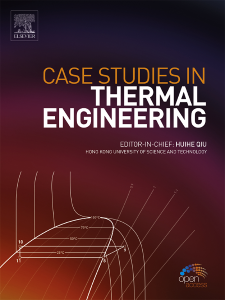Optimization of piezo pump and air impact cooling based on a synthetic jet
IF 6.4
2区 工程技术
Q1 THERMODYNAMICS
引用次数: 0
Abstract
A synthetic jet piezo (PE) pump with an inlet channel structured akin to a diffuser/nozzle, featuring smoothed walls, was developed. The synthetic jet was characterized by analyzing the internal flow field of the PE pump. Furthermore, the flow performance of this novel PE pump was compared with that of a basic PE pump, thereby demonstrating the advantages of the proposed design. Utilizing regression equations and standardized effect plots derived from the response surface method, both the main and interaction effects of parameters on the flow rate were assessed. Subsequently, the flow performance of the optimized PE pump was evaluated through experimental testing. Additionally, air impact cooling experiments were conducted, focusing on the influence of the impact distance on cooling performance. The findings indicated that the PE pump's open cavity height, closed cavity height, outlet diameter, and orifice diameter were 1.3 mm, 0.5 mm, 1.5 mm, and 0.8 mm, respectively. The proposed synthetic jet PE pump achieved a flow rate of 1832.3 ml/min at 50 Vpp and 4.6 kHz. Furthermore, it was observed that the operation of the PE pump reduced the temperature of the heater by 63 % at an impact distance of 20 mm.
基于合成射流的压电泵和空气冲击冷却的优化
我们开发了一种合成射流压电(PE)泵,其入口通道结构类似于扩散器/喷嘴,具有平滑的内壁。通过分析 PE 泵的内部流场,对合成射流进行了表征。此外,还将这种新型 PE 泵的流动性能与基本 PE 泵的流动性能进行了比较,从而证明了拟议设计的优势。利用响应面法得出的回归方程和标准化效应图,评估了各参数对流量的主效应和交互效应。随后,通过实验测试评估了优化 PE 泵的流量性能。此外,还进行了空气冲击冷却实验,重点研究冲击距离对冷却性能的影响。结果表明,聚乙烯泵的开腔高度、闭腔高度、出口直径和孔径分别为 1.3 毫米、0.5 毫米、1.5 毫米和 0.8 毫米。在 50 Vpp 和 4.6 kHz 的条件下,拟议的合成喷射聚乙烯泵的流速达到了 1832.3 毫升/分钟。此外,据观察,在 20 毫米的冲击距离内,聚乙烯泵的运行使加热器的温度降低了 63%。
本文章由计算机程序翻译,如有差异,请以英文原文为准。
求助全文
约1分钟内获得全文
求助全文
来源期刊

Case Studies in Thermal Engineering
Chemical Engineering-Fluid Flow and Transfer Processes
CiteScore
8.60
自引率
11.80%
发文量
812
审稿时长
76 days
期刊介绍:
Case Studies in Thermal Engineering provides a forum for the rapid publication of short, structured Case Studies in Thermal Engineering and related Short Communications. It provides an essential compendium of case studies for researchers and practitioners in the field of thermal engineering and others who are interested in aspects of thermal engineering cases that could affect other engineering processes. The journal not only publishes new and novel case studies, but also provides a forum for the publication of high quality descriptions of classic thermal engineering problems. The scope of the journal includes case studies of thermal engineering problems in components, devices and systems using existing experimental and numerical techniques in the areas of mechanical, aerospace, chemical, medical, thermal management for electronics, heat exchangers, regeneration, solar thermal energy, thermal storage, building energy conservation, and power generation. Case studies of thermal problems in other areas will also be considered.
 求助内容:
求助内容: 应助结果提醒方式:
应助结果提醒方式:


